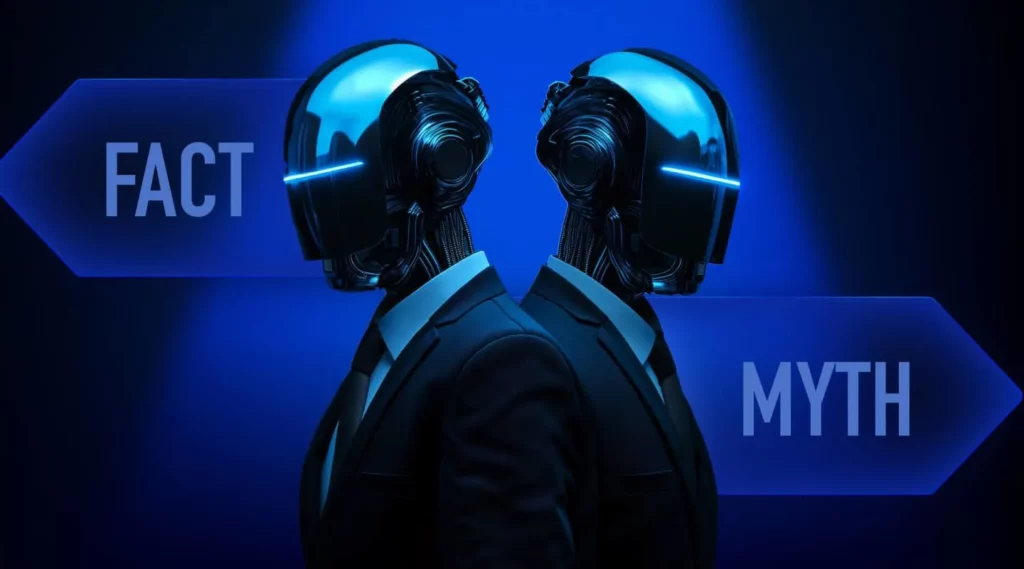
Introduction
In an era where artificial intelligence (AI) is no longer just a buzzword but a tangible driver of change, it’s crucial to separate the wheat from the chaff. The term “intelligence” in AI often gets conflated with human intelligence, leading to a host of myths that blur the lines between science fiction and technological reality.
Follow us on LinkedIn for everything around Semiconductors & AI
AI’s Alleged Autonomy
One of the most pervasive myths is that AI systems can autonomously gain agency, self-learn, and even pose a threat to human life. It’s important to distinguish between Narrow AI, which excels at specific tasks, and the hypothetical concept of Artificial General Intelligence (AGI) that could possess human-like learning and reasoning. Current AI can learn and adapt within its programming. An AI playing chess can improve its strategies, but it can’t rewrite its own code or decide to play a different game.
While AI itself isn’t inherently dangerous, there are potential risks associated with its misuse. Biased or poorly designed systems could have unintended consequences. Fortunately, safeguards are being developed, such as ethical guidelines for AI development and algorithms designed to prevent bias.
Read More: UMC Unveils World’s First 3D RFSOI Solution with 45% Size Reduction – techovedas
Emotional AI: A Misconception
The idea that AI can experience human-like emotions such as fear or ambition is another misconception. AI’s “decisions” are based on data and algorithms, not emotions.
Facial recognition technology is a prime example of Narrow AI at work. It employs deep learning algorithms to compare live captured images with stored face prints for identity verification. This technology is widely used in security systems at airports, criminal detection, and even unlocking smartphones. AI in facial recognition doesn’t possess emotions or consciousness; it operates purely on data analysis and pattern recognition.
Read More: $30 Billion: Meta’s Investment in NVIDIA GPUs to Supercharge AI Development – techovedas
The AGI Mirage
Artificial General Intelligence (AGI), a hypothetical AI that can understand, learn, and apply knowledge in a general way, is often thought to be just around the corner. However, the reality is that we’ve still got significant hurdles to overcome even in narrow AI applications, like achieving full autonomous driving. Unlike science fiction portrayals of super-intelligent machines, AGI isn’t likely to appear overnight. The challenges involved are immense. AGI would require breakthroughs in areas like:
- Machine Learning: Current AI excels at learning specific tasks from vast amounts of data. AGI would need to learn and adapt across a much broader range of situations, similar to how humans do.
- Reasoning and Problem-solving: Solving complex problems and reasoning through situations that haven’t been explicitly programmed requires a level of critical thinking current AI lacks.
- Common Sense and General Knowledge: Understanding the nuances of the world and applying that knowledge to new situations is a hallmark of human intelligence. AGI would need to develop a similar ability.
AI and Job Displacement
AI can also create new jobs in areas like data analysis, AI development, and cybersecurity. There’s a narrative that AI “takes” jobs, but it’s more nuanced than that. While automation powered by AI may displace workers in sectors with repetitive tasks, such as manufacturing, data entry, or customer service, it also creates demand for new roles in areas requiring human-computer collaboration. Business owners and managers ultimately make the decisions to replace human workers with AI or other alternatives, but they should consider the potential for reskilling their existing workforce to adapt to the changing landscape.
Productivity and AI
Lastly, while AI has the potential to significantly boost productivity, it’s not a silver bullet. The integration of AI into workflows must be thoughtfully managed to harness its full potential.
AI’s influence on scientific research is notable, offering a benefits that are revolutionizing the field. From powerful referencing tools to optimized research design, AI is enhancing our understanding of complex problems. It accelerates data analysis and develops novel hypothesis generation, thereby increasing the efficiency and impact of scientific studies. Moreover, AI applications in research are growing rapidly, with papers utilizing AI being more likely to be highly cited.
Conclusion
As we navigate through the AI revolution, it’s imperative to approach the subject with a critical mind. By debunking these myths, we can foster a more informed discourse on AI’s role in society and its true capabilities. As we delve deeper into the complexities of AI, it becomes evident that separating fact from fiction is essential. Moreover, understanding the nuances of AI enables us to make informed decisions about its implementation and regulation. Therefore, debunking myths is not only necessary but also beneficial in shaping the future of AI.




